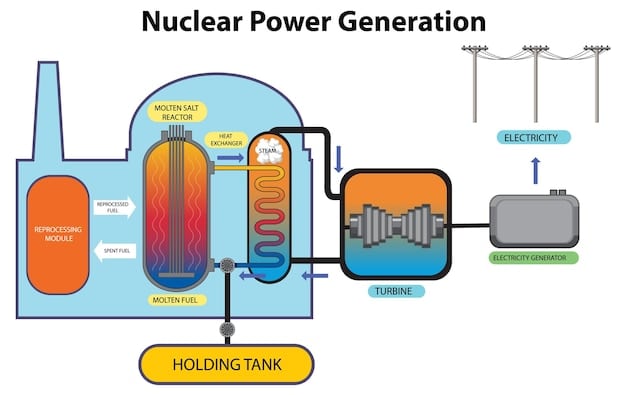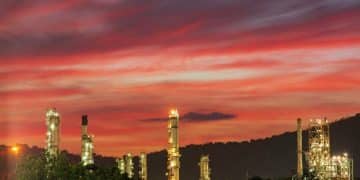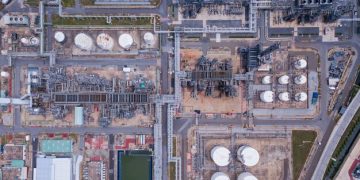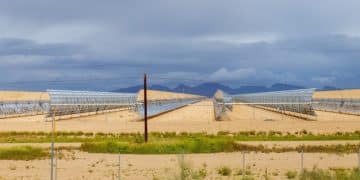Carbon Capture in the US: Are Pilot Projects Proving Viability?

Recent pilot projects in the US are providing crucial data on the economic and practical feasibility of carbon capture technologies, a key strategy for mitigating climate change.
Are carbon capture technologies finally viable? Analyzing Recent Pilot Projects in the US is crucial to understanding whether this technology can play a significant role in mitigating climate change. The United States has been at the forefront of developing and testing these technologies, with numerous pilot projects aiming to capture carbon dioxide emissions from power plants and industrial facilities.
Understanding Carbon Capture Technologies
Carbon capture technologies aim to prevent large quantities of carbon dioxide (CO2) from entering the atmosphere by capturing it at the source or even directly from the air. These technologies are being explored as a way to reduce greenhouse gas emissions, particularly from sectors that are difficult to decarbonize.
Types of Carbon Capture
There are several types of carbon capture technologies, each designed for different applications and sources of CO2 emissions.
- Post-Combustion Capture: This involves capturing CO2 from flue gases after combustion. It’s typically used in power plants and industrial facilities.
- Pre-Combustion Capture: This method removes CO2 before combustion. Fuel is partially oxidized to create a mixture of hydrogen and CO2, making CO2 capture easier.
- Oxy-Fuel Combustion: This process burns fuel in nearly pure oxygen, producing a flue gas that is mainly CO2 and water, simplifying CO2 capture.
Each of these methods has its advantages and is suited to different types of industrial processes. Post-combustion is often seen as more adaptable to existing infrastructure, while pre-combustion and oxy-fuel can be more efficient in new facilities designed with carbon capture in mind.

Overall, understanding these different approaches is the first step in assessing the viability and potential of carbon capture as a key strategy in fighting climate change.
Recent US Pilot Projects: An Overview
Several pilot projects in the US are demonstrating the potential of carbon capture technologies. These projects are essential for understanding the practical challenges and economic feasibility of scaling up carbon capture.
Key Pilot Projects in the US
These projects vary in scale, technology, and the industries they serve, providing a comprehensive overview of carbon capture’s potential.
- Petra Nova (Texas): While no longer operational, Petra Nova was one of the largest post-combustion carbon capture projects on a coal-fired power plant. It aimed to capture over 90% of the CO2 emissions from a portion of the plant.
- Illinois Industrial Carbon Capture and Storage Project: This project captures CO2 from an ethanol plant and stores it underground, demonstrating carbon capture from a non-power generation source.
- National Carbon Capture Center (Alabama): This is a research and testing facility focused on advancing carbon capture technologies, offering a platform for pilot projects and technology development.
These projects give crucial practical examples of carbon capture and storage in action, and help understand the economic viability as well.
These projects provide real-world data on the effectiveness, scalability, and costs associated with carbon capture. They are critical for informing policy decisions and investment strategies aimed at deploying carbon capture technologies more widely.
Technological Advancements Driving Viability
Advancements in materials science, chemical engineering, and process optimization are making carbon capture technologies more efficient and cost-effective. These improvements are crucial for the widespread adoption of carbon capture.
Innovations in Capture Materials
The development of new materials is a key area of innovation in carbon capture. These materials are designed to selectively capture CO2, improving the efficiency and reducing the cost of the capture process.
- Advanced Solvents: New solvents are being developed to improve CO2 absorption and reduce energy consumption during regeneration.
- Membrane Technology: Membranes can selectively separate CO2 from gas mixtures, offering a potentially less energy-intensive alternative to traditional solvent-based capture.
- Solid Sorbents: Solid materials that capture CO2 through adsorption are being explored for their potential to lower energy requirements and costs.
These materials represent cutting-edge research and development efforts aimed at making carbon capture more economically and environmentally sustainable.

Continuous research into innovative materials is promising to push carbon capture to the forefront.
Economic Factors Influencing Carbon Capture
The economic viability of carbon capture technologies is critical for their widespread deployment. Factors such as capital costs, operating expenses, and revenue streams all play a significant role.
Costs and Incentives
The costs associated with carbon capture can be substantial, but various incentives and policies are helping to make these technologies more economically attractive.
The 45Q tax credit in the US provides financial incentives for capturing and storing CO2, which can significantly reduce the net cost of carbon capture projects. Government funding for research, development, and demonstration projects is also essential for advancing these technologies and reducing costs.
Creating markets for captured CO2, such as for enhanced oil recovery or the production of valuable chemicals, can provide additional revenue streams for carbon capture projects. This can turn a cost center into a potential profit center.
A combination of cost reductions through technological advancements and financial incentives through policy support are crucial for making carbon capture economically viable and attractive to investors and industries.
Challenges and Future Directions
While carbon capture technologies hold significant promise, several challenges need to be addressed for their widespread deployment. These challenges range from technical issues to regulatory and public acceptance concerns.
Overcoming the Hurdles
Several key challenges must be addressed to fully realize the potential of carbon capture technologies.
- High Capital Costs: The initial investment required to build carbon capture facilities can be substantial, deterring potential investors.
- Energy Intensity: Some carbon capture processes can be energy-intensive, reducing their overall environmental benefit.
- Storage Capacity and Safety: Ensuring safe and secure storage of captured CO2 is crucial to prevent leakage and environmental damage.
Addressing these challenges requires continued research and development, supportive policies, and public engagement to build confidence in carbon capture technologies. Overcoming the hurdles involved in these technologies is key.
In conclusion, carbon capture technologies still face many obstacles that must be conquered.
Policy and Regulatory Landscape in the US
Government policies and regulations play a crucial role in shaping the deployment of carbon capture technologies. Understanding the current landscape and potential future developments is essential for stakeholders.
Key Policies and Regulations
A supportive policy environment can incentivize the development and deployment of carbon capture technologies.
The 45Q tax credit provides significant financial incentives for carbon capture projects, making them more economically viable. Regulations regarding CO2 storage, such as permitting requirements and monitoring protocols, are essential for ensuring safe and responsible deployment. Government funding for research, development, and demonstration projects is also critical for advancing carbon capture technologies. Regulations are essential to allow carbon capture to continue to develop.
Policies that promote carbon capture technologies encourage carbon reduction.
Government support, regulatory certainty, and international collaboration are essential for fostering a thriving carbon capture industry and achieving meaningful reductions in greenhouse gas emissions.
| Key Aspect | Brief Description |
|---|---|
| 🌱 Carbon Capture | Technologies that prevent CO2 from entering the atmosphere. |
| 🏭 Pilot Projects | US projects providing data on carbon capture viability. |
| 💰 Economic Factors | Capital costs, incentives, and revenue streams influencing deployment. |
| ⚖️ Policy Landscape | Government policies and regulations shaping carbon capture. |
FAQ
▼
The main types are post-combustion, pre-combustion, and oxy-fuel combustion. Each method captures CO2 at different stages of the energy production process.
▼
The 45Q tax credit is a US government incentive for capturing and storing CO2, providing financial benefits to companies undertaking carbon capture projects.
▼
The main challenges include high capital costs, the energy intensity of capture processes, and ensuring safe and secure CO2 storage.
▼
Pilot projects provide real-world data, technological and economic feasibility, which aids in improving the technologies and informing policy and investment decisions.
▼
Supportive policies and regulations incentivize development and deployment of carbon capture, provide financial incentives, and ensure responsible deployment.
Conclusion
In conclusion, **Are carbon capture technologies finally viable? Analyzing Recent Pilot Projects in the US** suggests that while challenges remain, significant advancements and supportive policies are making these technologies increasingly promising for mitigating climate change.





